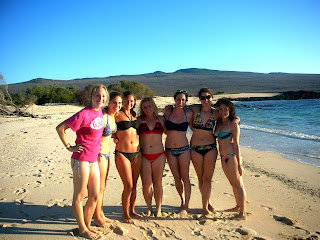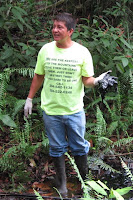I’m a list person. I make gazillions of lists, most of the time for practical reasons, sometimes just for fun (yes, I know, my idea of “fun” can be a little odd…) My lists range from “things to do tomorrow” to “things to do in the next year” to “dreams for my future.” I keep lists of books I want to read and movies I want to see and people I need to call or e-mail, and I start making my Christmas lists (both things I want to give and things I’d like to receive) around October, just for the fun of it. When I was younger I made lists like “things to do with friends this summer” and “places I want to travel to,” and I still make lots and lots of lists of favorite quotes and Bible verses, because there is rarely a day that goes by where I don’t need a little (or a lot) of inspiration and God’s word to keep me going.
This week has been tough, mainly because I’ve been battling a terribly intense migraine and struggling with getting behind on some of the things on my “lists,” and just feeling generally deflated and discouraged. And I guess if I’m being honest, which I always try to be, those two words have characterized a fair amount of my time here so far. That’s a much longer blog post for a different time, but basically this whole experience has not been at all what I expected, or what I had hoped for. I know and I’m trusting in the promise that I DO have a purpose here – and even if I don’t understand it now (which I don’t), that God has promised to bring something totally beautiful out of me being here, that I will affect people I meet here without even knowing it (and vice versa), and that He is working something really deep and really strong inside of me – this I am sure of, because I can literally feel it, and it’s probably going to take a lot more pain and internal wrestling to get there, but He’s promised that He will never take me through more than I can bear, and I believe that.
When I look at the title of my blog, Live in Joy – one of my personal mantras that lies at the top of my “ultimate life goals” list – I feel a little bit like I’ve failed. If you had asked me two months ago I would have told you in a second that I consider myself a joyful, joyous, joy-filled person – and that I strive to choose joy in the midst of tough and trying circumstances. But now…I’m doubting that. I’m struggling to choose joy. It’s not coming easy – it’s more like a battle, and most days I feel like I’m losing. And then today that wonderful verse came to mind, right when I needed it, that Paul writes in 2 Corinthians 12:10: “But he said to me, ‘My grace is sufficient for you, for my power is made perfect in weakness.’ Therefore I will boast all the more gladly about my weaknesses, so that Christ’s power may rest on me. That is why, for Christ’s sake, I delight in weaknesses, in insults, in hardships, in persecutions, in difficulties. For when I am weak, then I am strong.” It almost seems offensive to compare any of my own “sufferings” with those of Paul, but the truth of this verse really speaks to me right now. I feel weak a lot of the time. I've wanted to give up, go back to what’s easy and comfortable and warmly familiar. But Paul also writes earlier in 1:5 that “For just as we share abundantly in the sufferings of Christ, so also our comfort abounds through Christ.” Sometimes, I'm learning, God leads us through places and times like these because we need to come back to Him, trust in Him, find comfort and joy solely and wholly from Him – it’s a hard lesson, but a crucial one.
Anyways, to get back to my original musing about all my various lists, I made 3 "joy lists" yesterday, mainly for my own emotional and spiritual purposes and as a distraction from my migraine, but I figured I might as well share them :) We often let the difficult things or negative things or the anything-less-than-perfect things completely overshadow the beauty and blessings that we are surrounded by, wherever we go, so I decided to resurrect the presence of those things in my mind and in my life, as well as remind myself (and all of you!) of who God says we are.
10 things that make me happy:*
1. Coffee dates with my 91-year-old Ecuadorian friend Gonzalo
2. Spinach/apple/almond salads at Cassolette
3. Fresh-squeezed orange juice
4. Listening to The Civil Wars on repeat
5. Reading for pleasure (a.k.a., not for school)
6. The most delicious Sushi EVER at Noe
7. Wearing sweatpants all the time (sorry not sorry)
8. The constantly perfect weather – warm and sunny with the occasional afternoon thunderstorm
9. Dark chocolate
10. Only having to walk 5 steps from my building to get a cappuccino
*I realize half of these things are food. It was unintentional, but I guess if you know me, it makes sense.
10 things I’m grateful for:
1. My wonderful family back home
2. My wonderful host family here
3. Having a lot more free time than normal
4. Flatirons sermon podcasts
5. Exercise (mainly, actually, the endorphins) and feeling healthy
6. Everyone being incredibly patient with me and gracious about my Spanish
7. New days and new beginnings
8. Facebook and Skype, for making it easy to keep in touch with everyone I love back in Boulder/at Duke/my Kenya team
9. Music, and especially songs that capture exactly how I’m feeling or relate perfectly to my life
10. GRACE
10 things that God says I am:
1. uniquely gifted (Rom. 12:4-8, 1 Cor. 12)
2. completely accepted (Rom. 15:7)
3. beautiful and radiant (Song of Songs 5, 6)
4. a victorious over-comer (1 John 4:4, Rom. 8:37)
5. perfect and complete (1 Cor. 6:17)
6. of great value and worth (Matt 10:30-31, 1 Pet 1:18-19)
7. God's masterpiece (Eph. 2:10)
8. being transformed (Rom. 12:1-2)
9. totally forgiven (Col. 2:13)
10. unconditionally loved (John 15:9, 16:27)








